Papers by Iraklis Varlamis
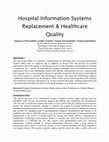
International Journal of Reliable and Quality E-Healthcare, 2012
The aim of this paper is to develop a methodology for deciding when a Hospital Information System... more The aim of this paper is to develop a methodology for deciding when a Hospital Information System (HIS) must be replaced and in addition to discuss how the decision for system replacement affects the quality of healthcare services. In our hypothesis, the Hospital IS has been in operation for a period of time and the Hospital managers have to choose between the replacement with a new Information System (IS) and the continuation of its use. Leaving aside the economic factors concerning the return of a possible investment, the decision is still difficult and will be based on scientific and technological factors. The proposed methodology employs confidential information from the Hospital, which relates to the system operation and usability, the satisfaction of doctors and patients etc. It also examines the entire working environment and common factors that affect the choice of Hospital managers (e.g. financial constraints).
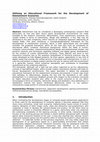
Edutainment may be considered a developing contemporary research field particularly as new and op... more Edutainment may be considered a developing contemporary research field particularly as new and open source game development environments are made available to the research community. Nevertheless, most edutainment scenarios are usually limited in terms of interactivity, design and aesthetics, a fact that may be attributed to the task complexity, which requires an integrated approach addressing all related fields. This work introduces a conceptual/operational framework for the development of edutainment scenarios, which is both game-based and rich-media oriented. The proposed framework, which for the main part must be considered an educational effort, combines theoretical background -within the fields of human-computer communication, interaction/educational design and entertainment studies- and practical solutions and techniques regarding software and digital games development, for the creation of custom edutainment scenarios. These abstract and more or less theoretical scenarios due to the seamless embodiment of technical practices may be easily developed as fully fledged products, be them games, applications or any kind of digital media that provide the unified service of education and entertainment. In such a case the end product (a digital system) permits the user to interact with the environment in a game-like manner, which enhances learnability and contributes to knowledge acquirement as the underlying objective.
The continuously and rapidly changing landscape in the fields of communications, Internet and soc... more The continuously and rapidly changing landscape in the fields of communications, Internet and social media make it imperative for professionals to better understand the role of Information and Communication Technologies and their impact to everyday activities. Several frameworks have been proposed in order to capture various dimensions of social media and measure their impact in people's social, professional and other activities. The effect of social media and Web 2.0 applications in the healthcare sector is also significant. This paper examines Greek healthcare professionals' attitudes towards Internet social media and mobile technologies, explores their familiarity with social networks and associates their answers with their professional profile. Results are discussed within the context of the growing international relevant literature.
Operational and Technical approaches to the development of regional telemedicine centers
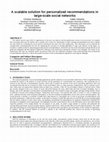
Proceedings of the 18th Panhellenic Conference, Oct 2, 2014
The modern trend in many Web 2.0 applications is that users can interact with the applications in... more The modern trend in many Web 2.0 applications is that users can interact with the applications in terms of social activity, for example they can express their trust for another user or another user's review etc. Bearing that in mind, creating recommendations for users could go one step further by reclaiming the social network information they share into these applications. This information can be exploited for creating better recommendations but also for optimizing the execution of existing algorithms in large scale datasets. In this paper, we introduce a scalable model for generating personalized user recommendations, which first uses the social information and divides the social graph into subgraphs and then applies Collaborative Filtering on the preferences information related to each subgraph. The results of our experiments show that our proposed model can perform faster than the traditional techniques while producing high level personalized recommendations. Moreover, it allows the parallel execution of the recommendation algorithm in each separate subgraph.
Γιαννακουλόπουλος, Ανδρέας & Βαρλάμης, Ηρακλής (2008) “Ζητήματα λειτουργίας και διαχείρισης Δυνητικών Κοινοτήτων”, Κεφάλαιο σε συλλογικό τόμο, Δυνητικές Κοινότητες: Κοινωνιο-Ψυχολογικές Προσεγγίσεις και Τεχνικές Εφαρμογές, Πάντειο Πανεπιστήμιο (σσ. 251-268)., 2008
Το κεφάλαιο αυτό έχει ως σκοπό να περιγράψει και να αναλύσει τις βασικές θεωρητικές και πρακτικές... more Το κεφάλαιο αυτό έχει ως σκοπό να περιγράψει και να αναλύσει τις βασικές θεωρητικές και πρακτικές αρχές του σχεδιασμού, της λειτουργίας και της διαχείρισης των δυνητικών κοινοτήτων. Σε πρώτο επίπεδο προσδιορίζονται οι λόγοι για τη σύσταση και ύπαρξη μιας δυνητικής κοινότητας και σχετίζονται με το περιεχόμενο και τις υπηρεσίες που προσφέρονται στα μέλη της. Παράλληλα δίνεται ιδιαίτερη έμφαση στα χαρακτηριστικά της “χρηστικότητας” και της “κοινωνικότητας” που πρέπει να εμφανίζει μια κοινότητα για να θεωρηθεί επιτυχημένη. Τέλος δίνονται βασικές κατευθύνσεις στους επίδοξους οργανωτές και διαχειριστές μιας τέτοιας προσπάθειας.
Strengthening Privacy in Healthcare Social Networks
Medical Data Privacy Handbook, 2015
SEWeP
Proceedings of the ninth ACM SIGKDD international conference on Knowledge discovery and data mining - KDD '03, 2003
Proceedings of the 2nd international workshop on Advanced architectures and algorithms for internet delivery and applications - AAA-IDEA '06, 2006
A large part of the hidden web resides in weblog servers. New content is produced in a daily basi... more A large part of the hidden web resides in weblog servers. New content is produced in a daily basis and the work of traditional search engines turns to be insufficient due to the nature of weblogs. This work summarizes the structure of the blogosphere and highlights the special features of weblogs. In this paper we present a method for ranking weblogs based on the link graph and on several similarity characteristics between weblogs. First we create an enhanced graph of connected weblogs and add new types of edges and weights utilising many weblog features. Then, we assign a ranking to each weblog using our algorithm, BlogRank, which is a modified version of PageRank.
Ηλεκτρονικές Κοινότητες Μάθησης
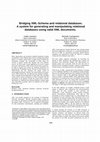
Proceedings of the 2001 ACM Symposium on Document engineering - DocEng '01, 2001
Many organizations and enterprises establish distributed working environments, where different us... more Many organizations and enterprises establish distributed working environments, where different users need to exchange information based on a common model. XML is widely used to facilitate this information exchange. The extensibility of XML allows the creation of generic models that integrate data from different sources. For these tasks, several applications are used to import and export information in XML format from the data repositories. In order to support this process for relational repositories we developed the X-Database system. The base of this system is an XML-Schema file that describes the logical model of interchanged information. Initially, the system analyses the syntax of the XML-Schema file and generates the relational database. Then it handles the decomposition of valid XML files according to that Schema and the composition of XML documents from the information in the database. Finally the system offers a flexible mechanism for modifying and querying database contents using only valid XML documents, which are validated over the XML-Schema file's rules.
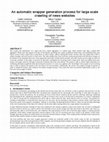
Proceedings of the 18th Panhellenic Conference on Informatics - PCI '14, 2014
The creation and maintenance of a large-scale news content aggregator is a tedious task, which re... more The creation and maintenance of a large-scale news content aggregator is a tedious task, which requires more than a simple RSS aggregator. Many news sites appear every day on the Internet, providing new content in different refresh rates, well established news sites restrict access to their content only to subscribers or online readers, without offering RSS feeds, whereas other sites update their CMS or website template and lead crawlers to fetch errors. The main problem that arises from this continuous generation and alteration of pages on the Internet is the automated discovery of the appropriate and useful content and the dynamic rules that crawlers need to apply in order not to become outdated. In this paper we present an innovative mechanism for extracting useful content (title, body and media) from news articles web pages, based on automatic extraction of patterns that form each domain. The system is able to achieve high performance by combining information gathered while discovering the structure of a news site, together with "knowledge" that acquires at each crawling step, in order to improve the quality of the next steps of its own procedure. Additionally, the system can recognize changes in patterns in order to rebuild the domain rules whenever the domain changes structure. This system has been successfully implemented in palo.rs, the first news search engine in Serbia.
Using Social Data for Personalizing Review Rankings
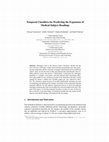
Ontologies such as the Medical Subject Headings (MeSH) and the Gene Ontology (GO) play a major ro... more Ontologies such as the Medical Subject Headings (MeSH) and the Gene Ontology (GO) play a major role in biology and medicine since they facilitate data integration and the consistent exchange of information between different entities. They can also be used to index and annotate data and literature, thus enabling efficient search and analysis. Unfortunately, maintaining the ontologies manually is a complex, error-prone, and time and personnel-consuming effort. One major problem is the continuous growth of the biomedical literature, which expands by almost 1 million new scientific papers per year, indexed by Medline. The enormous annual increase of scientific publications constitutes the task of monitoring and following the changes and trends in the biomedical domain extremely difficult. For this purpose, approaches that try to learn and maintain ontologies automatically from text and data have been developed in the past. The goal of this paper is to develop temporal classifiers in order to create, for the first time to the best of our knowledge, an automated method that may predict which regions of the MeSH ontology will expand in the near future.

Classification of movement data concerning user's activity recognition via mobile phones
Proceedings of the 4th International Conference on Web Intelligence, Mining and Semantics (WIMS14) - WIMS '14, 2014
ABSTRACT Smartphones are becoming a powerful platform for event recognition due to the number of ... more ABSTRACT Smartphones are becoming a powerful platform for event recognition due to the number of sensors they are equipped with. This provides an opportunity to apply data mining techniques on movement data in order to recognize people's daily activities without changing their routine. In this paper, we present a methodology for collecting and analysing user activity information with a smartphone application. This information can be further exploited in various applications ranging from m-health (e.g. fitness application) and transportation (e.g. user driving habits detection) to m-commerce (e.g. shopping recommendations). In order to demonstrate this methodology, we have developed GPSTracker a prototype application for Android phones, which collects position, speed, altitude and time information and performs real-time classification of user's movement. The processed information is collected in a private user folder, on a cloud storage service, and can be further processed in order to extract aggregate user habits, or in order to detect user activity over time and provide recommendations. We also provide a visualisation of user trajectories, as recorded and classified by GPSTracker application. We exploited all the possible sensors of the smartphone and employed additional geo-location data from public transportation services. Finally, we tested several movement classification algorithms and trajectory pattern analysis techniques in order to improve the performance of our activity recognition process.
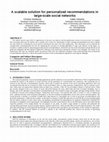
Proceedings of the 18th Panhellenic Conference on Informatics - PCI '14, 2014
The modern trend in many Web 2.0 applications is that users can interact with the applications in... more The modern trend in many Web 2.0 applications is that users can interact with the applications in terms of social activity, for example they can express their trust for another user or another user's review etc. Bearing that in mind, creating recommendations for users could go one step further by reclaiming the social network information they share into these applications. This information can be exploited for creating better recommendations but also for optimizing the execution of existing algorithms in large scale datasets. In this paper, we introduce a scalable model for generating personalized user recommendations, which first uses the social information and divides the social graph into subgraphs and then applies Collaborative Filtering on the preferences information related to each subgraph. The results of our experiments show that our proposed model can perform faster than the traditional techniques while producing high level personalized recommendations. Moreover, it allows the parallel execution of the recommendation algorithm in each separate subgraph.
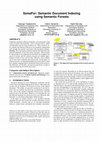
Proceedings of the 21st ACM international conference on Information and knowledge management - CIKM '12, 2012
Traditional document indexing techniques store documents using easily accessible representations,... more Traditional document indexing techniques store documents using easily accessible representations, such as inverted indices, which can efficiently scale for large document sets. These structures offer scalable and efficient solutions in text document management tasks, though, they omit the cornerstone of the documents' purpose: meaning. They also neglect semantic relations that bind terms into coherent fragments of text that convey messages. When semantic representations are employed, the documents are mapped to the space of concepts and the similarity measures are adapted appropriately to better fit the retrieval tasks. However, these methods can be slow both at indexing and retrieval time. In this paper we propose SemaFor, an indexing algorithm for text documents, which uses semantic spanning forests constructed from lexical resources, like Wikipedia, and WordNet, and spectral graph theory in order to represent documents for further processing.
IEEE Transactions on Systems, Man, and Cybernetics: Systems, 2014
Social network analysis has recently gained a lot of interest because of the advent and the incre... more Social network analysis has recently gained a lot of interest because of the advent and the increasing popularity of social media, such as blogs, social networking applications, micro-blogging, or customer review sites. In this environment, trust is becoming an essential quality among user interactions and the recommendation for useful content and trustful users is crucial for all the members of the network. In this work, we introduce a framework for handling trust in social networks, which is based on a reputation mechanism that captures the implicit and explicit connections between the network members, analyzes the semantics and dynamics of these connections and provides personalized user recommendations to the network members.
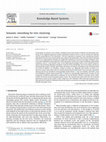
Knowledge-Based Systems, 2013
In this paper we present a new semantic smoothing vector space kernel (S-VSM) for text documents ... more In this paper we present a new semantic smoothing vector space kernel (S-VSM) for text documents clustering. In the suggested approach semantic relatedness between words is used to smooth the similarity and the representation of text documents. The basic hypothesis examined is that considering semantic relatedness between two text documents may improve the performance of the text document clustering task. For our experimental evaluation we analyze the performance of several semantic relatedness measures when embedded in the proposed (S-VSM) and present results with respect to different experimental conditions, such as: (i) the datasets used, (ii) the underlying knowledge sources of the utilized measures, and (iii) the clustering algorithms employed. To the best of our knowledge, the current study is the first to systematically compare, analyze and evaluate the impact of semantic smoothing in text clustering based on 'wisdom of linguists', e.g., WordNets, 'wisdom of crowds', e.g., Wikipedia, and 'wisdom of corpora', e.g., large text corpora represented with the traditional Bag of Words (BoW) model. Three semantic relatedness measures for text are considered; two knowledge-based (Omiotis [1] that uses WordNet, and WLM [2] that uses Wikipedia), and one corpus-based (PMI [3] trained on a semantically tagged SemCor version). For the comparison of different experimental conditions we use the BCubed F-Measure evaluation metric which satisfies all formal constraints of good quality cluster. The experimental results show that the clustering performance based on the S-VSM is better compared to the traditional VSM model and compares favorably against the standard GVSM kernel which uses word co-occurrences to compute the latent similarities between document terms. 1 Though there are slight conceptual differences between the terms 'semantic similarity' and 'semantic relatedness', for the purposes of this work this differentiation is not important. Therefore, the two terms might be used interchangeably for the remaining of the paper.








Uploads
Papers by Iraklis Varlamis